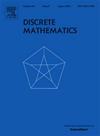Spectral extremal problems on outerplanar and planar graphs
IF 0.7
3区 数学
Q2 MATHEMATICS
引用次数: 0
Abstract
Let and be the maximum spectral radius over all n-vertex F-free outerplanar graphs and planar graphs, respectively. Define as t vertex-disjoint l-cycles, as the graph obtained by sharing a common vertex among t edge-disjoint l-cycles and as the disjoint union of copies of . In the 1990s, Cvetković and Rowlinson conjectured maximizes spectral radius in outerplanar graphs on n vertices, while Boots and Royle (independently, Cao and Vince) conjectured does so in planar graphs. Tait and Tobin (2017) [22] determined the fundamental structure as the key to confirming these two conjectures for sufficiently large n. Recently, Fang et al. (2024) [12] characterized the extremal graph with in planar graphs by using this key. In this paper, we first focus on outerplanar graphs and adopt a similar approach to describe the key structure of the connected extremal graph with , where F is contained in but not in . Based on this structure, we determine and along with their unique extremal graphs for all , and large n. Moreover, we further extend the results to planar graphs, characterizing the unique extremal graph with for all , and large n.
外平面与平面图上的谱极值问题
设spexOP(n,F)和spexP(n,F)分别为所有n顶点无F的外平面图和平面图的最大谱半径。定义tCl为t个顶点不相交的l环,Bt,l为t个边不相交的l环共享一个公共顶点得到的图,(t+1)K2为K2的t+1个拷贝的不相交并。在20世纪90年代,cvetkovovic和Rowlinson通过K1∨Pn−1在外平面图上n个顶点上实现谱半径的最大化,Boots和Royle(独立地,Cao和Vince)通过K2∨Pn−2在平面图上实现谱半径的最大化。Tait and Tobin(2017)[22]将基本结构确定为在足够大的n下确认这两个猜想的关键。最近Fang et al.(2024)[12]利用该关键在平面图形中用spexP(n,tCl)表征极值图。本文首先关注外平面图,采用类似的方法描述spexOP(n,F)连通极值图的关键结构,其中F包含在K1∨Pn−1中,但不包含在K1∨((t−1)K2∪(n−2t+1)K1中。在此基础上,我们确定了所有t≥1、l≥3和大n的spexOP(n,Bt,l)和spexOP(n,(t+1)K2)及其唯一极值图,并将结果进一步推广到平面图上,用spexP(n,Bt,l)刻画了所有t≥3、l≥3和大n的唯一极值图。
本文章由计算机程序翻译,如有差异,请以英文原文为准。
求助全文
约1分钟内获得全文
求助全文
来源期刊

Discrete Mathematics
数学-数学
CiteScore
1.50
自引率
12.50%
发文量
424
审稿时长
6 months
期刊介绍:
Discrete Mathematics provides a common forum for significant research in many areas of discrete mathematics and combinatorics. Among the fields covered by Discrete Mathematics are graph and hypergraph theory, enumeration, coding theory, block designs, the combinatorics of partially ordered sets, extremal set theory, matroid theory, algebraic combinatorics, discrete geometry, matrices, and discrete probability theory.
Items in the journal include research articles (Contributions or Notes, depending on length) and survey/expository articles (Perspectives). Efforts are made to process the submission of Notes (short articles) quickly. The Perspectives section features expository articles accessible to a broad audience that cast new light or present unifying points of view on well-known or insufficiently-known topics.
 求助内容:
求助内容: 应助结果提醒方式:
应助结果提醒方式:


